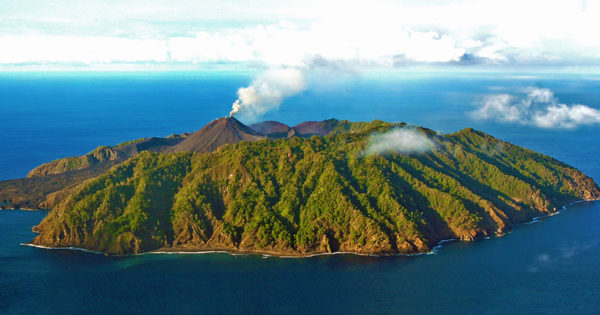We are going to see an actual volcano!” shrieked my best friend, as we boarded the ship. The year was 2004, six months before the Indian Ocean tsunami. The Indian Coast Guard had organised an excursion for students to India’s only active volcano, Barren Island, and we were over the moon about being selected to see nature at its most primordial.
As the piercing sound of the ship’s horn reverberated on the shores being left behind, my friends and I decided to find a place on the deck instead of settling into cabins. A journey on a ship to a live volcano was no less than an adventure and we were determined to make the most of it.
Located about 135 km north-east of Port Blair, the tiny Barren Island in the Andaman Sea is situated at the cross of the seismically active Indian and Burmese plates. The uninhabited island is 1.8 million years old and its massive foundations rest at a depth of 2,250 meter below the surface. The island volcano’s first recorded eruption dates back to 1,787, with the the last large scale eruption occurring around 150 years ago.
However, while the existence of this volcano has been known for centuries, little-publicized research and limited access has long rendered this uninhabited island an enigma unto itself.
Dusk had arrived by the time we caught our first glimpse of the giant recluse. Our destination was still three hours away but Barren Island, silhouetted against the coral pink horizon, was already visible. As our ship cut through the waters, streaks of neon-green bioluminescent plankton trailing in its wake, the island drew nearer. A solitary sentinel keeping a silent watch over the dark sea.
The sultry air and the gentle rocking motion of the ship must have lulled me to sleep. I awoke to the sounds of exclamations from my friends and a mesmerizing, once-in-a-lifetime sight.
The 2-km-wide caldera of the volcano on Barren Island was spewing plumes of thick sulphur-rich smoke, much like a giant chimney.
Occasionally, tiny balls of fire erupted from the rim of the volcano, glowing red due to burning ash, to singe the sky. At places where the dark grey slopes, peppered by tenacious shrubs and trees, reached the sea, steam rose in swirling spirals as if reaching for the sky.
As the ship skirted the island to find a suitable spot to anchor (no one is allowed to land on the Barren Island), I kept an eye out for the island’s small population of feral goats that I had read about.
How these goats got here remains a mystery, but the story goes that in 1891, a passing steamer from Port Blair offloaded some of these on the island. Apparently, the British would often leave livestock on islands in case they were stranded there in the future!
Over the years, the hardy goats (they are known to drink saline water) have survived the harsh conditions and occasional eruptions on Barren Island. However, it was dark by the time we had reached the island and I failed to spot any of these goats.
Sipping hot tea on the gently rocking deck, we watched the stars emerge in the moonlit sky as the silent volcano watched over us. After a simple dinner of rice, dal and sabzi, we returned to our places on the deck to listen to NIO scientists tell us about the unique ecosystem of the Barren Island.
Surrounded by nothing but water for miles, the ocean around Barren Island provides a place of rest and rejuvenation for large marine creatures like turtles, manta rays and reef sharks on their migrations.
As the bedrock of the island is black, the sand on its narrow beaches also has a deep purple-black hue. Underwater, this unique darker-than-usual canvas forms the perfect backdrop for vibrant reefs of coral, sponges and sea anemones.
As the night deepened, our conversation also began to ebb. Soon, the only sound that could be heard was that of the waves crashing onto the island shores. As I drifted off to sleep, I wondered what life on this enigmatic island would be like.
Early morning, we were woken up by the crew and sent into our cabins. The sea had taken a turbulent turn as the ship was heading back to Port Blair. As we carefully retreated from the deck, waves began splashing the decks, bringing with them all kinds of fish. We wanted to stay and enjoy the sight of the raging sea a little longer but a stern crew member ordered us in before we were tossed aboard.
After hours of negotiating through the huge crests and troughs of the rough sea, our ship finally arrived at at the Phoenix Bay Jetty in Port Blair. As I thanked the captain and left the ship to meet my waiting parents, my exhausted yet exhilarated mind was already dreaming of a return visit to the enigmatic island.
Note: In January 2017, a team of scientists led by Dr. Abhay V. Mudholkar and Dr. B Nagender Nath, from CSIR-National Institute of Oceanography (CSIR-NIO), witnessed the Barren Island volcano billowing smoke and spewing lava. The researchers made their observations when they were on a research trip to collect sea floor samples from the Andaman Basin.
Getting there
Generally, ships for Barren Island leave thrice a week from Phoenix Bay Jetty in Port Blair. The schedule and fare is subject to change, depending on the weather and number of passengers.The island can also be visited by chartering boats with the permission of Forest Department.



Leave a reply